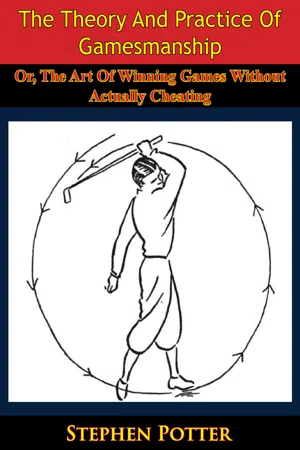
The Theory And Practice Of Gamesmanship; Or, The Art Of Winning Games Without Actually Cheating
- 86 pages
- English
- ePUB (mobile friendly)
- Available on iOS & Android
The Theory And Practice Of Gamesmanship; Or, The Art Of Winning Games Without Actually Cheating
About this book
Gamesmanship as a civilised art is as old as the competitive spirit in man. It is polite psychological warfare. It is the moral equivalent of assault and battery. It is, as the subject of this book points out, The Art of Winning Games Without Actually Cheating. Anyone who has ever played any games for keeps has discovered the Gamesman either in himself or in an opponent. In its simplest terms the poker player's bluff is a device of gamesmanship. While winning games without actually cheating may seem to some scrupulous sportmen to be treading the fair-play borderline, the author points out 'The true Gamesman is always the Good Sportsman.' If you find your game is slipping, whatever it might be-golf, tennis, bridge, poker, chess, craps or croquet-this is the book for you. Apply the power of the 'ploy' or, as we would say, the 'Indian sign.' After reading Gamesmanship you, too, can win without actually cheating.—Print Ed.
Frequently asked questions
- Essential is ideal for learners and professionals who enjoy exploring a wide range of subjects. Access the Essential Library with 800,000+ trusted titles and best-sellers across business, personal growth, and the humanities. Includes unlimited reading time and Standard Read Aloud voice.
- Complete: Perfect for advanced learners and researchers needing full, unrestricted access. Unlock 1.4M+ books across hundreds of subjects, including academic and specialized titles. The Complete Plan also includes advanced features like Premium Read Aloud and Research Assistant.
Please note we cannot support devices running on iOS 13 and Android 7 or earlier. Learn more about using the app.
Information
VI—LOSEMANSHIP
The Primary Hamper.
Potter’s Improvement on the Primitive Hamper.
Table of contents
- Title page
- TABLE OF CONTENTS
- LIST OF ILLUSTRATIONS
- I-INTRODUCTORY
- II-THE PRE-GAME
- III-THE GAME ITSELF
- IV-WINMANSHIP
- V-LUNCHEONSHIP
- VI-LOSEMANSHIP
- VII-GAME BY GAME
- VIII-LOST GAME PLAY
- IX-GAMESMANIA
- APPENDIX I-THE KÖNINCK PORTRAIT OF DR. W. G. GRACE
- APPENDIX II-NOTE ON ETIQUETTE
- APPENDIX III-CHAPTER HEADINGS FROM “ORIGINS AND EARLY HISTORY OF GAMESMANSHIP”
- APPENDIX IV-DIET
- APPENDIX V-SOME EXTRACTS FROM THE “GAMESMAN’S HANDBOOK” FOR 1949